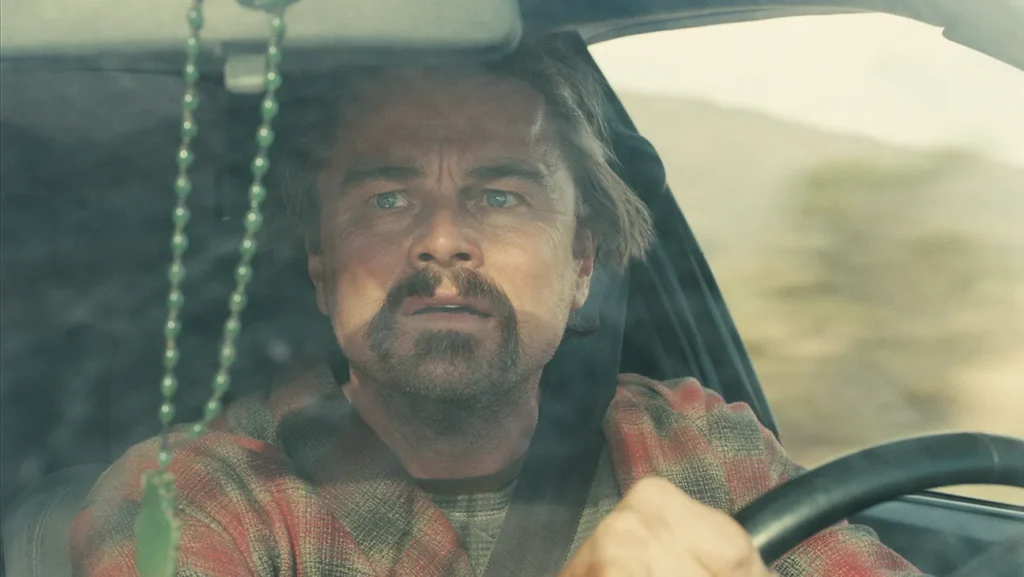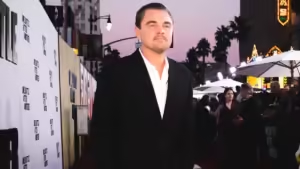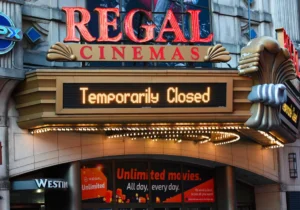
THE MASTER AND THE MOVIE STAR
DiCaprio’s screen presence remains one of Hollywood’s most valuable and profitable assets. Despite Paul’s stature as one of the great American directors of the 21st century, it was DiCaprio’s involvement that helped secure a budget of $130 million for his latest film, One Battle After Another. Paul’s name is already enshrined among the mavericks of cinema; his reputation precedes him, and his filmography is nothing short of immaculate, showcasing growth, maturity, and finesse. DiCaprio, meanwhile, has long been a champion of quality cinema, striking a fine balance between commerce and art. A regular collaborator with Spielberg and Scorsese, he is also an Academy Award winner for Best Actor.
It is One Battle After Another that best encapsulates this meeting of vision and ambition. Shot on VistaVision, Paul revived cameras that hadn’t been used since the 1960s because he believed the film needed that distinct aesthetic to achieve a rich and authentic cinematic look. The format produces finer film grain and higher-resolution images by running 35mm film horizontally, capturing twice the area of traditional 35mm cameras to create a widescreen frame. The choice serves the story well, allowing the film to feel both grand and intimate, sweeping in its landscapes and precise in its close-ups.
When you combine such dedication to the craft with one of the most bankable actors in the world, who is as committed as Paul to his art, you would expect not just a great film, which it certainly is, but also a box office success. Sadly, that has not been the case.
 DiCaprio at the London premiere of his film One Battle After Another
DiCaprio at the London premiere of his film One Battle After Another
A BOX OFFICE DISASTER DESPITE THE MOVIE STAR
DiCaprio has left no stone unturned in promoting the film, appearing everywhere from podcasts on YouTube to reels on Instagram. Yet there is something slightly jarring about seeing an actor of his calibre reduced to the level of TikTokers appearing in frolicky, dim-witted reels just to market the film. If spreading word of mouth, drawing crowds, and capturing attention now rely on such marketing gimmicks, it’s clear that star power has waned over time. Humanising once-untouchable icons may make them more relatable, but it’s a double-edged sword since it also diminishes their aura when they are placed on the same level as TikTokers.
Making them “relatable” through social media circuits has become the new normal, a necessary component of press tours and digital marketing. Even DiCaprio could, in theory, make himself more bankable in his forties by embracing this visibility. Yet it arguably inflicts more long-term harm than short-term gain, chipping away at the very essence of what made him magnetic in the first place. Not to mention such marketing strategies which have clearly failed to work in this case, given that the film has failed to even make its budget back. It is no news that Paul has never made films that have been huge commercial successes but given DiCaprio’s presence things do change.
In today’s cultural landscape, where the very idea of stardom seems to have shifted from permanence to trend, from aura to algorithm we are left hanging with a heavy question, Is the movie star dead?
THE MOVIE STAR IN THE ERA OF STREAMING SERVICES
Once, the movie star was an institution. People bought tickets not for the plot but for the name on the marquee — a Jimmy Stewart film, a Ray Milland film, a Bogart or a Pacino film. The film itself was an event, one that went beyond the ticket price. A movie night was dinner, the babysitter, the anticipation, and all of it hinged on the actor’s mystique, their ability to draw crowds through sheer presence. Today, that mystique is gone. Oversaturation has eroded desire. With stars at our disposal 24/7 on smartphones, talk shows, Instagram reels, and brand deals, the need to see them on the big screen is satiated long before the film opens.
Therefore, the role of streaming services in this collapse cannot be ignored either. When films were events, the movie star was the centerpiece, the reason to gather in a darkened room with hundreds of strangers. Now, streaming services have normalized instant access, collapsing that communal ritual into a private click. What was once iconic is now casual, what was once scarce is now disposable. A star appearing in a new film doesn’t feel special when you’ve already seen them in three different projects across streaming platforms in a single year. The very abundance of content has diluted the scarcity that once defined stardom.
 Warner Brother studio lot, Los Angeles
Warner Brother studio lot, Los Angeles
THE STUDIO AND THE MOVIE STAR
Studios, instead of preserving the mystique of their stars are eroding it further. Instead of protecting actors as rare presences, they encourage them to become digital brands, visible on every platform and responsive to every trend. Actors are made to sell their films through Instagram Q&As, TikTok challenges, viral dances, or meme-friendly moments, all of which might generate clicks but flatten their image. The aura that made Humphrey Bogart or Al Pacino untouchable vanishes when today’s stars are reduced to marketing mascots, competing for attention in the same space as influencers and YouTubers.
But is the decline of the movie star a stressor for the studios if they no longer rely on him? Warner Brothers was struggling financially last year, reporting an annual net loss of 11.3 billion dollars. Despite theatrical revenue showing an early boost, several high profile films failed to meet financial expectations reporting a heavy loss of hundreds of millions of dollars. Compared to 1.16 billion dollars from 2024 Warner Brothers has generated 4 billion dollars in theatrical revenue this year becoming the only studio to do so. And none of the films that performed strongly at the box office were headlined by any major movie stars.
 Regal Cinemas on 42nd street, New York (image source: abcnews4.com)
Regal Cinemas on 42nd street, New York (image source: abcnews4.com)
FINAL NAIL IN THE COFFIN
The audience has always been the ultimate force behind an actor’s stardom, transforming talent into a cultural icon through identification, engagement, and collective support. Their perception and sustained attention elevate performers into larger-than-life figures whose presence extends far beyond the screen. Yet when audiences cease to value craft, fail to recognize the cinematic experience, and ignore the importance of the big screen, stardom begins to hinge more on fleeting trends than on talent or dedication.
The blame, then, cannot rest solely with the studios, who must navigate the realities of business. The audience shares responsibility, growing complacent and neglecting the films that truly matter. In this landscape, the modern actor faces a paradox: to secure work, they must remain visible and relevant, chasing trends that are, by nature, ephemeral. Stardom has become fragile, dependent not on skill or presence, but on the whims of digital visibility, a transient reflection of fleeting attention rather than lasting artistry.
In the end, the movie star as we once knew them, untouchable, magnetic, and revered, may no longer exist. What remains is a shadow of fame, shaped as much by clicks and algorithms as by craft, a reminder that the golden age of stardom was never just about the actor, but also about the audience willing to believe in their magic.
For more news about entertainment and films, stay tuned at The World Times.



